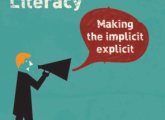Innovating your practice has to come from a core understanding that what you are doing will benefit those in your classroom. In terms of digital practice, all teachers can benefit from developing some key skills that will enhance core pedagogical principles. However, before you innovate you need to look to consolidate the cornerstones of your teaching: questioning, feedback, differentiation and assessment for learning, so that you have the confidence to know when using technology will have a positive impact, and is not just a gimmick.
Before I go any further:
Myth: You have to be IT savvy/had special training to use IT effectively in lessons. Reality: The majority of teachers, and this includes learning technologists like me, have had no/little IT training at all. All you need to get it to work is time and a sense of optimism. Anyone can use IT in lessons - it might just be that you need to seek the support of others in your school, but trust me, everything I use in the classroom requires no expertise or super powers… or else I would not be able to get it to work.
Sharing student work is one of the powerful things you can do as a teacher. Making work public gives it a wider audience, which can be transformative in terms of learning. It will probably come as no shock to be told that as a rule, pupils do not consider a teacher’s opinion as the be all and end all. An essay or piece of work written on a piece of paper will only be read by one teacher; this is a wasted opportunity. Sharing student work with the wider world tends to up the game of even the most reluctant learner. Who is going to read little Algernon’s poem now? Not just Sir or Miss, but actually maybe the head teacher, maybe his parents, maybe anyone in the world. Nothing encourages a child to proofread like knowing his or work is going to be read, widely and perhaps by strangers. Standard of literacy shoot through the roof, and suddenly everyone starts to care about their writing.
The right platform
Sounds good, right? There is no teacher in the land who doesn’t want students to develop and improve their work in school. The answer is not magic, it is in fact using the internet to give students’ work a wider audience. You can do this is a number of ways, the simplest of which is blogging. There are a number of blogging platforms that you could use. If you are a Google Apps for Education school, then Blogger is probably easiest as it falls within the Google family and children will already have logins. However, if you are not, then there are a number of free blogging platforms. Edu-Blogs is much used in schools, and is basically WordPress with a more ‘school friendly’ skin. I like WordPress itself, as you are able to add the learners as authors, but also moderate their posts before they go online. You can also do a fair bit to adjust the theme (the template that dictates how the blog looks) so that it is stylistically pleasing and appropriate for your subject.
The easy bit is setting up the blog and adding the students as authors. The aspect that is slightly more tricky is finding them an audience for their work. Obviously you will be blogging with the knowledge and support of the school (I am very much one for asking for forgiveness rather than permission when it comes to innovation – but this is not one of those times). Make sure that your head of department and SLT are aware of (and support) what you are doing. With this framework in place you can send home a URL website link to parents where they can see their offsprings’ work, and ask them to leave comments. In parallel with this, a fantastic homework to set is to ask the class to read each other’s posts and provide peer feedback. Having said that you need to create the right climate in your classroom for this to be productive. Students need to be trained in how to provide ‘FiSH’ type feedback (Friendly, Specific and Helpful), so that they avoid any inappropriate comments. In my experience, however, if children have been used to providing feedback they can become very effective at doing so.
Sticks and stones
This perhaps leads to the importance of every teacher being a teacher of esafety. It is not enough in a school to leave this work to those who teach IT; it must be embedded across the curriculum, especially if you as a subject teacher are planning to make use of online technology. Esafety and being a digital citizen need to be a part of a whole school concerted effort where there is a consistency of approach in every lesson. With that in mind, you also might consider sharing your students’ blogs on social media, for example on Twitter, Instagram or Pinterest to attract a wider audience. You could either do this from your own (teacher) social media account, or ask to use the school’s account if there is one. This will probably see the work getting an audience, and some lovely comments.
Hang on, though – what about any comments that are not positive or constructive? Well, as the blog admin, how you deal with this inevitability is up to you. You can have settings that will check with you before any comments are posted, and it is within your power to delete them before a student sees them. For me, however, it is more powerful to discuss the comments with the pupil concerned. In four years of blogging my students have only had one silly negative comment, and when I talked to the student concerned (and after a good discussion of trolling) we decided it was a bit sad that this person felt the need to try and attract attention to themselves in that way. This is actually not a bad life lesson to learn in school: not everyone is nice, but we need not pay attention to them. It’s a question of building resilience.
Sharing student work digitally is an extension of what is possible in the classroom, but raises the stakes in terms of the expectations that you can have in terms of young people’s work and learning. As a teacher, the IT skills required to run this are minimal, but you can really seek maximum impact in terms of raising aspirations and attainment.
ABOUT THE AUTHOR
Rachel Jones is a Google Certified Teacher interested in creativity and innovation in the classroom. She thrives on trying new things and engaging and empowering students. Her blog was a finalist in the 2013 EduBlog awards and was recommended by The Guardian as a must-read for 2014. Rachel is a regular blogger for The Huffington Post and a lively contributor on Twitter @rlj1981. She also curated ‘Don’t Change the Light Bulbs’ (Crown House); a must-read anthology of mantras, lists, aphorisms, advice and activities from some of the UK’s most switched-on educators.







